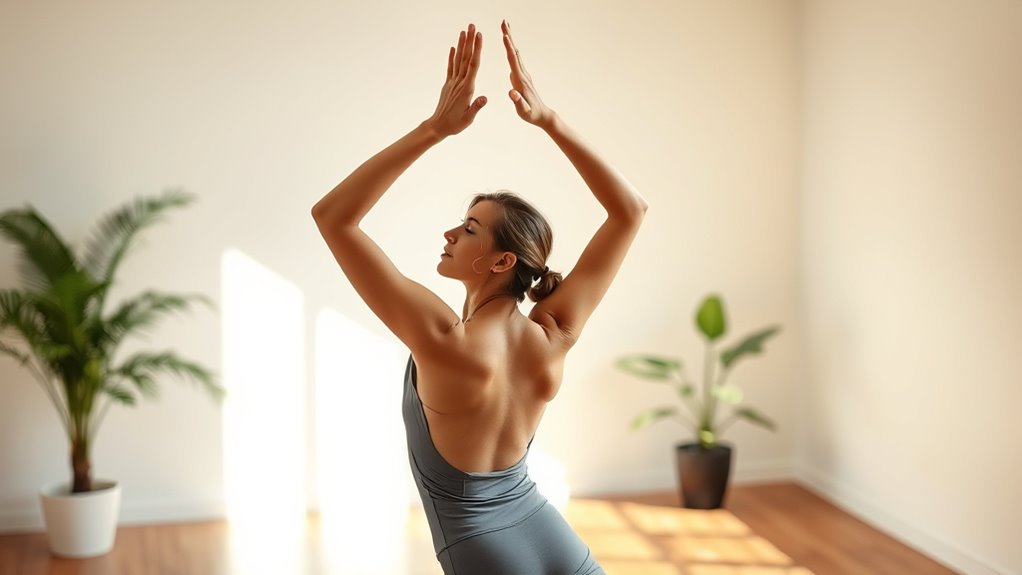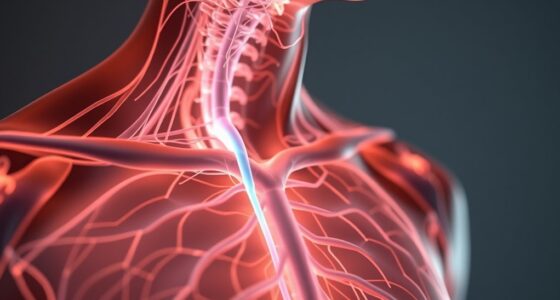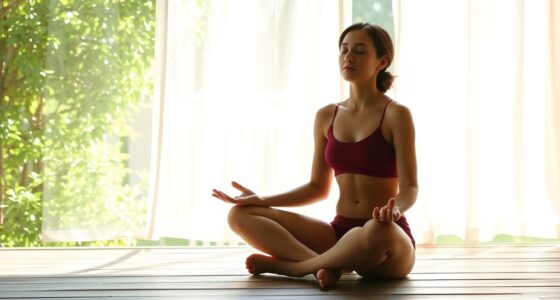Movement practices that connect mind and body, like gentle yoga, tai chi, or qigong, integrate mindful breathing and meditation to foster mental clarity and emotional balance. These routines strengthen muscles, improve flexibility, and promote relaxation by anchoring your attention in the present moment. As you focus on breath and sensations, you’ll develop greater self-awareness and resilience. Keep exploring and discover how these practices can transform your overall well-being and inner harmony.
Key Takeaways
- Movement practices like yoga and tai chi integrate gentle movements with breath awareness to foster mind-body connection.
- Mindful walking and dance encourage present-moment focus, enhancing awareness of physical sensations and emotional states.
- Active meditation combines movement with breathing techniques to promote mental clarity and emotional balance.
- Practices that emphasize breath awareness during movement improve concentration and reduce stress.
- Developing consistent mindfulness in movement routines deepens self-awareness and cultivates holistic well-being.

Many movement practices seamlessly link the mind and body, offering more than just physical benefits. When you engage in these practices, you’re not only strengthening your muscles or increasing flexibility but also cultivating mental clarity and emotional balance. A key aspect of many of these approaches is breath awareness, which serves as a bridge between your physical sensations and your mental state. By paying close attention to your breath, you learn to anchor yourself in the present moment, reducing stress and fostering a sense of calm. Breath awareness isn’t just about inhaling and exhaling; it’s about noticing the quality, rhythm, and depth of your breath during movement. This mindful focus enhances your connection to your body, helping you recognize subtle sensations and movements that often go unnoticed.
Incorporating meditation techniques into movement practices elevates this mind-body connection even further. For example, practices like yoga or tai chi blend gentle physical movements with mindful breathing and meditation techniques. As you flow through poses or sequences, you’re encouraged to stay present, observing how your body feels with each *transition*. This deliberate mindfulness cultivates a deeper awareness of your physical and mental states, enabling you to release tension and foster inner peace. Meditation techniques—such as focusing on your breath, observing sensations, or repeating a calming mantra—help quiet mental chatter and anchor your attention. When combined with movement, these techniques allow you to experience a heightened sense of awareness, making each session more than just exercise; it’s a form of active meditation.
As you practice, you’ll notice that breath awareness and meditation techniques naturally deepen your concentration and reduce mental distractions. This heightened focus can improve your overall sense of well-being, making daily stressors easier to manage. It also encourages you to listen more deeply to your body’s signals, recognizing when you’re tense or fatigued, and adjusting your movements accordingly. This attunement creates a more sustainable practice that supports both physical health and emotional resilience. Over time, the integration of breath awareness and meditation techniques in movement becomes second nature, transforming your routine into a powerful tool for self-awareness. You’ll find yourself more present, centered, and connected to your body’s needs, regardless of the activity. Ultimately, these practices empower you to cultivate a harmonious balance between mind and body, fostering a holistic sense of health and *vitality*.
Frequently Asked Questions
Can Movement Practices Help Reduce Anxiety and Depression?
Yes, movement practices can help reduce anxiety and depression. Engaging in activities like mindfulness meditation and breathing exercises calms your mind and body, easing stress and emotional tension. When you incorporate gentle movement, it boosts your mood and helps you feel more grounded. These practices improve your overall mental health by promoting relaxation, increasing self-awareness, and breaking negative thought patterns, making it easier to manage anxiety and depression effectively.
How Quickly Can I Expect Mental Benefits From Regular Practice?
Timing expectations for mental health improvements vary, but many people notice benefits within a few weeks of regular practice. You might feel reduced anxiety or better mood after just 10 sessions, while deeper changes can take a month or more. Consistency is key; the more regularly you engage, the faster you’ll likely see positive effects. Be patient and stay committed to experience lasting mental health improvements.
Are These Practices Suitable for People With Physical Disabilities?
You might wonder if these practices suit people with physical disabilities. The good news is, adaptive techniques and accessibility considerations make many movement practices inclusive. You can customize exercises to fit your abilities, ensuring safe and effective engagement. Always consult with professionals to tailor activities to your needs. With proper adjustments, you can enjoy the mental and physical benefits, making these practices accessible and beneficial for everyone.
What Equipment Is Necessary to Start These Movement Practices?
To get started, you’ll need minimal gear, making it accessible for most. Equipment essentials include a comfortable mat for support, a sturdy chair for seated exercises, and optional props like blocks or straps for added flexibility. You don’t need much—just a quiet space and your intent to connect mind and body. With these simple tools, you can easily begin your practice and enjoy its many benefits.
Can Children and Seniors Safely Participate in These Activities?
This question is essential because safe participation is the foundation of any activity. Children and seniors can absolutely join, but it’s important to consider age appropriateness and adaptive modifications. With gentle adjustments, movement practices can be tailored to fit their needs, making the experience safe and enjoyable. Always consult health professionals and prioritize comfort, ensuring no one feels overwhelmed—like trying to hold back a tidal wave of vitality!
Conclusion
By embracing movement practices that connect your mind and body, you open a deeper sense of awareness and balance. Some believe this synergy can even boost mental clarity and emotional resilience, leading to a more fulfilled life. While science continues to explore these effects, trusting in the power of mindful movement can transform your well-being. So, take that step today—your mind and body may thank you in ways you never expected.









